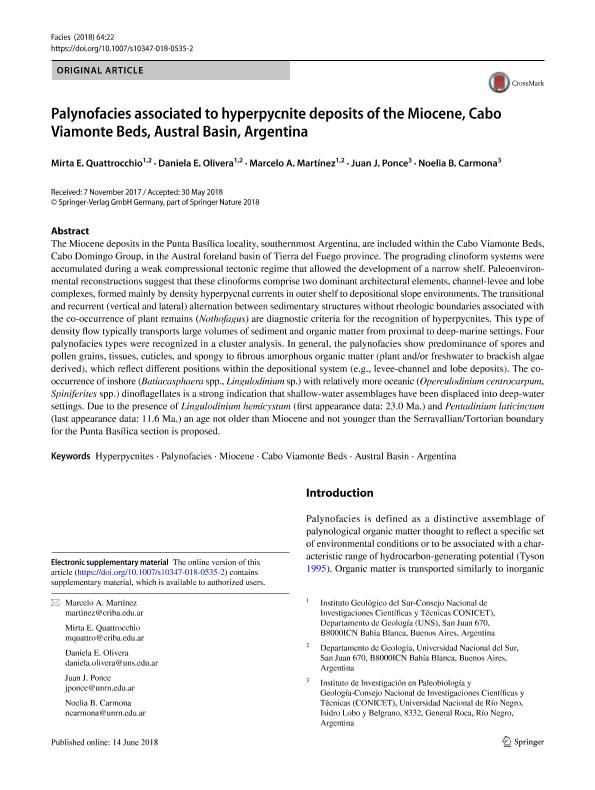Artículo
Palynofacies associated to hyperpycnite deposits of the Miocene, Cabo Viamonte Beds, Austral Basin, Argentina
Quattrocchio, Mirta Elena ; Olivera, Daniela Elizabeth
; Olivera, Daniela Elizabeth ; Martinez, Marcelo Adrian
; Martinez, Marcelo Adrian ; Ponce, Juan Jose
; Ponce, Juan Jose ; Carmona, Noelia Beatriz
; Carmona, Noelia Beatriz
 ; Olivera, Daniela Elizabeth
; Olivera, Daniela Elizabeth ; Martinez, Marcelo Adrian
; Martinez, Marcelo Adrian ; Ponce, Juan Jose
; Ponce, Juan Jose ; Carmona, Noelia Beatriz
; Carmona, Noelia Beatriz
Fecha de publicación:
07/2018
Editorial:
Springer
Revista:
Facies
ISSN:
0172-9179
Idioma:
Inglés
Tipo de recurso:
Artículo publicado
Clasificación temática:
Resumen
The Miocene deposits in the Punta Basílica locality, southernmost Argentina, are included within the Cabo Viamonte Beds, Cabo Domingo Group, in the Austral foreland basin of Tierra del Fuego province. The prograding clinoform systems were accumulated during a weak compressional tectonic regime that allowed the development of a narrow shelf. Paleoenvironmental reconstructions suggest that these clinoforms comprise two dominant architectural elements, channel-levee and lobe complexes, formed mainly by density hyperpycnal currents in outer shelf to depositional slope environments. The transitional and recurrent (vertical and lateral) alternation between sedimentary structures without rheologic boundaries associated with the co-occurrence of plant remains (Nothofagus) are diagnostic criteria for the recognition of hyperpycnites. This type of density flow typically transports large volumes of sediment and organic matter from proximal to deep-marine settings. Four palynofacies types were recognized in a cluster analysis. In general, the palynofacies show predominance of spores and pollen grains, tissues, cuticles, and spongy to fibrous amorphous organic matter (plant and/or freshwater to brackish algae derived), which reflect different positions within the depositional system (e.g., levee-channel and lobe deposits). The co-occurrence of inshore (Batiacasphaera spp., Lingulodinium sp.) with relatively more oceanic (Operculodinium centrocarpum, Spiniferites spp.) dinoflagellates is a strong indication that shallow-water assemblages have been displaced into deep-water settings. Due to the presence of Lingulodinium hemicystum (first appearance data: 23.0 Ma.) and Pentadinium laticinctum (last appearance data: 11.6 Ma.) an age not older than Miocene and not younger than the Serravallian/Tortorian boundary for the Punta Basílica section is proposed.
Palabras clave:
Argentina
,
Austral Basin
,
Cabo Viamonte Beds
,
Hyperpycnites
,
Miocene
,
Palynofacies
Archivos asociados
Licencia
Identificadores
Colecciones
Articulos(IIPG)
Articulos de INSTITUTO DE INVESTIGACION EN PALEOBIOLOGIA Y GEOLOGIA
Articulos de INSTITUTO DE INVESTIGACION EN PALEOBIOLOGIA Y GEOLOGIA
Articulos(INGEOSUR)
Articulos de INST.GEOLOGICO DEL SUR
Articulos de INST.GEOLOGICO DEL SUR
Citación
Quattrocchio, Mirta Elena; Olivera, Daniela Elizabeth; Martinez, Marcelo Adrian; Ponce, Juan Jose; Carmona, Noelia Beatriz; Palynofacies associated to hyperpycnite deposits of the Miocene, Cabo Viamonte Beds, Austral Basin, Argentina; Springer; Facies; 64; 3; 7-2018; 1-14
Compartir
Altmétricas



